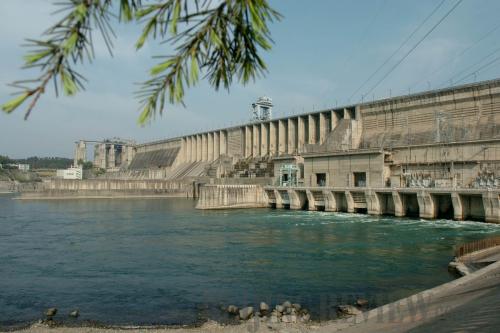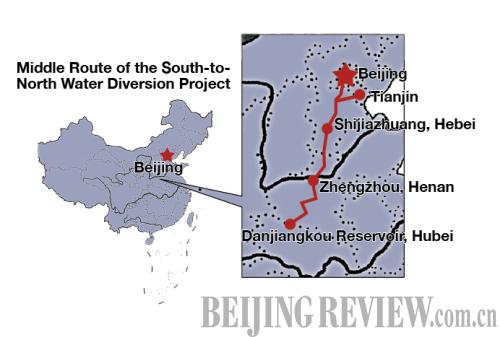|
 |
|
PURE WATER: Danjiangkou Reservoir is a beacon for China's environment protection efforts in the coming years (HAO TONGQIAN) |

Journalists joined Danjiangkou Mayor Zeng Wenhua at Danjiangkou Reservoir in Hubei Province on May 27 for a special demonstration: Zeng would taste the basin's water. After drawing a bucket of clear water, with no signs of impurities, Zeng ladled out a cup and drank it without hesitation.
"This is water from Danjiangkou Reservoir," he said proudly, "and it can be drunk directly."
A skeptical journalist also scooped some water into a cup from the bucket and, after taking a sip of the water, said, "It's sweet."
But more than inviting members of the media to taste the water, the demonstration was meant to show the water's quality, since Danjiangkou Reservoir will soon provide Beijing and Tianjin with the life-giving liquid through the channels of the middle route of the South-to-North Water Diversion Project. Water potability is a concern among people living along the project's path.
Construction of Danjiangkou Reservoir on the Hanjiang River, a branch of the middle reaches of the Yangtze River, started in 1958 and wrapped up in 1973. Covering an area of 84,000 hectares, it has a total storage capacity of 8.1 billion cubic meters. In its early years, the reservoir was used for power generation, shipping, aquiculture, flood control and irrigation.
Protection measures
To address water shortages in north China, the Central Government decided to launch the South-to-North Water Diversion Project, selecting Danjiangkou Reservoir as a water source for the middle route of the project. Since 2005, the government has increased the height of the reservoir's dam—from 162 meters to 176.6 meters—in order to store more water for diversion to the north. With its water storage volume increased to 29 billion cubic meters, the reservoir has become the largest man-made lake in Asia.
In order to make the reservoir water clean, said Zeng, Danjiangkou City has carried out an ecological development strategy, focusing on the ecological construction of the forests in the locality.
 |
|
A HEAVEN OF COEXISTENCE: The population of egrets living around Danjiangkou Reservoir has increased rapidly in recent years due to improvements in the local environment (XINHUA) | In 2001, the local government initiated a program to turn the cultivated land around the reservoir into forestland. During the past decade, the city has afforested 180,000 hectares of land. The forest coverage rate around the reservoir has increased from 34.2 percent to 52.6 percent.
Now, lush forests are abundant around Danjiangkou Reservoir, as saplings planted a decade ago have already grown to full size.
With agriculture as the major industry around the reservoir and its nearby valley, pollution caused by agricultural production was a major target for prevention and control. Zeng said the local government offered money and technology to encourage farmers to develop pollution-free farm produce, and organized technical personnel to develop pollution-free tea, orange and aquatic products.
The local authorities launched hygiene campaigns in rural areas, relieving pollution caused by household wastes and lowering farmers' reliance on forest resources.
Reducing industrial pollutants was another priority. In the past five years, the local government closed 47 heavy-polluting enterprises and carried out pollution-control schemes for 30 enterprises, inputting a total of 340 million yuan ($49.78 million) into environment protection.
To prevent domestic pollution to the reservoir area, two sewage works were built in 2009, and another two such projects are under construction.
Emphasis has also been placed on water and soil conservation. By the end of 2009, the city had completed water and soil conservation on 60,000 hectares of land. Upon observation, this Beijing Review reporter saw no large tracts of barren land around the reservoir.
"We strove to ensure water quality at Level A or B," Zeng said. According to China's standards on surface water, water with quality at Level A or B can be used for drinking after simple sterilization with chlorine.
From ginger to green
The region around Danjiangkou Reservoir is rich in ginger. Saponins extracted from ginger are used to produce hundreds of medicines, earning ginger the name "medicinal gold." The highest price for saponins once reached 600,000 yuan ($87,848) per ton.
Five years ago, Zeng said, nearly 90 percent of the world's saponins were supplied by China, while the planting and processing capacities around Danjiangkou Reservoir accounted for 36 percent and 44 percent of the country's total.
| 